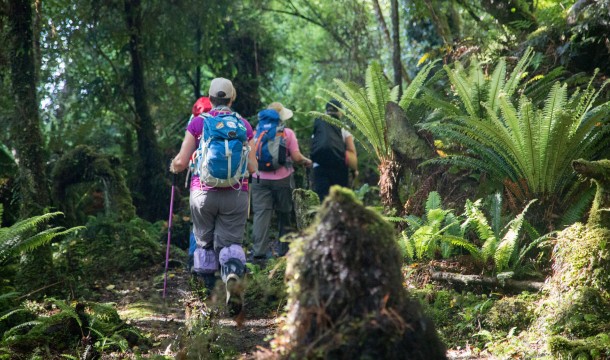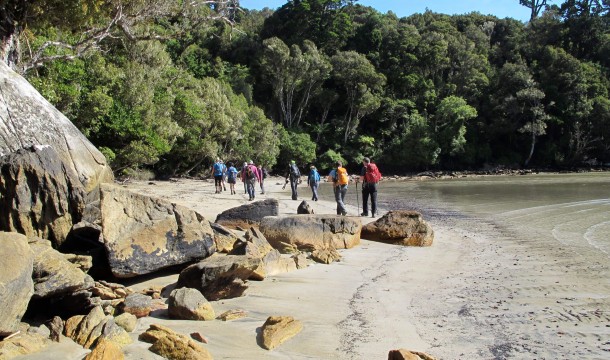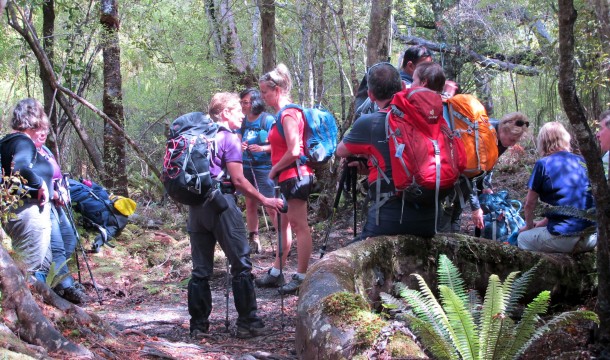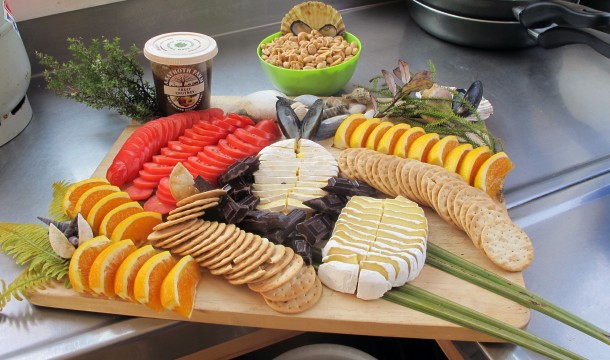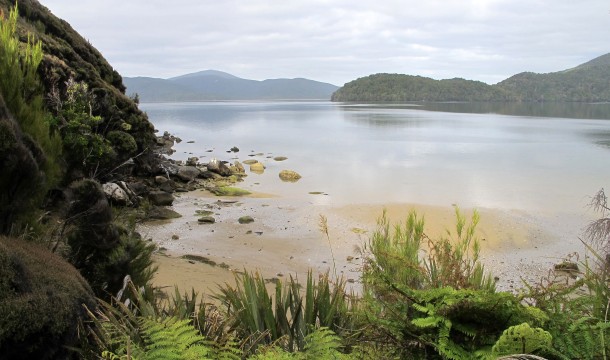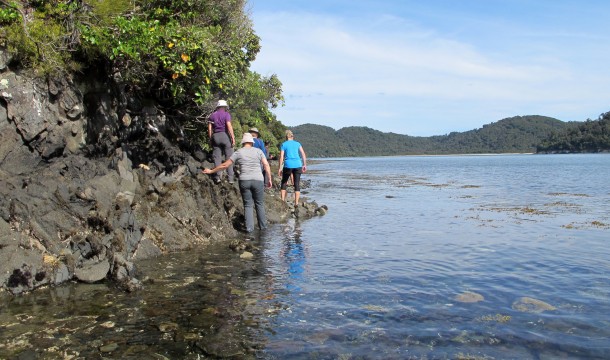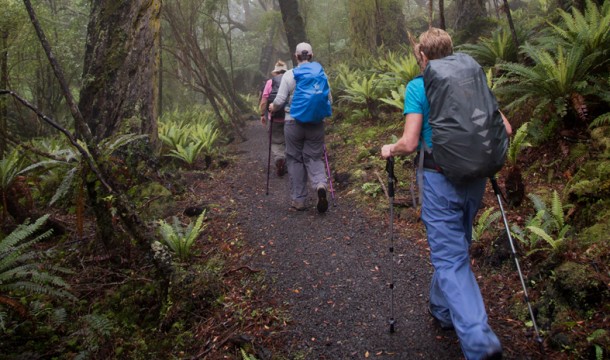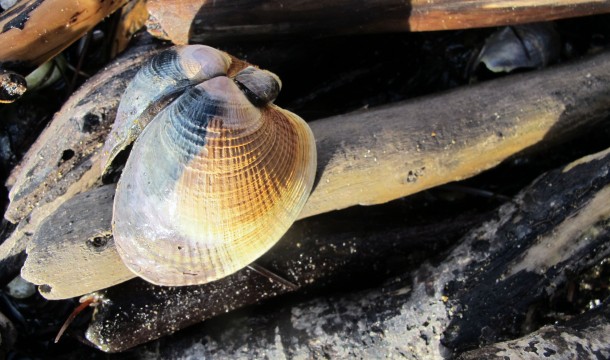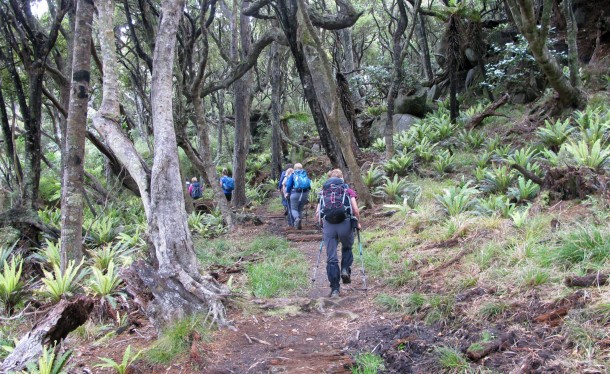Trip Details
The Rakiura Great Walk is classified as one of New Zealand’s Great Walks. An enjoyable and varied outdoor adventure. It is a relatively easy three-day walk, mainly through regenerating native forest, with beautiful coastal sections and sites of historical significance. The walk is a loop from Oban, Halfmoon Bay, to Port William, North Arm (Paterson Inlet), returning to Halfmoon Bay. Find out more in our trip itinerary below.
LOCATION
Rakiura Great Walk, Rakiura National Park, Stewart Island.
ACCOMMODATION ON THE HIKE
We stay at Port William Hut and North Arm Hut. These are operated by the Department of Conservation and our bunk space is pre-booked. Facilities are shared with other independent hikers.
Facilities at the huts include: Sleeping area, separated from kitchen/communal area. The sleeping area is partitioned into two areas with 12 bunks each. The bunks have mattresses. The kitchen has work benches, sinks with cold running water, tables and seating. There is an outside washbasin with cold running water and long drop toilets.
FOOD ON OUR TRIP
We provide healthy meals and snacks (plus the sweet things too), with local seafood where possible. We cater for most dietary requirements.
Meals on our trips include:
Day 1: Lunch, pre-dinner snacks, dinner, hot drinks. Snacks during the day.
Day 2: Breakfast, lunch, pre-dinner snacks, dinner, hot drinks. Snacks during the day.
Day 3: Breakfast, lunch. Snacks during the day.
WEAR AND BRING
Carry a light pack, we recommend 30 - 35 litres with your personal belongings, light sleeping bag and space for lunch and snacks for the day. See: Wear and Bring.
We operate an Outdoor Shop (Gear Hire / Purchases).
PACKAGE OPTION
Contact us for customised packages to include travel to and from Stewart Island by ferry or plane and accommodation before and / or after your guided walk.
Other Recommended Tours
We recommend doing the following tours to compliment your Rakiura Great Walk:
BIRDS SEEN
More commonly seen birds include:
Land birds: Tui, bellbird, South Island tomtit, fantail, grey warbler, red-crowned parakeet, South Island kaka, wood pigeon, kingfisher.
Shore birds: Black-backed gull, red-billed gull, variable oystercatcher, white-face heron, paradise shelduck.
WILDLIFE SEEN
New Zealand sealion, fur seals are seen occasionally.
FLORA
The flora is varied from coastal to inland forest and comprises original and regenerating sections of mixed hardwood podocarp forest and manuka. Ferns, mosses, and a variety of orchids are present.
Testimonial
"...We leave with wonderful memories of a unique NZ environment, thanks to the passion Furhana has for imparting her knowledge and understanding of the area. As our guide she ensured we were safe, well fed (actually, extremely well fed!) and aware of all the spectacular vistas we were passing. The highlight was being up close and personal with a kiwi on our last day..."
Itinerary
-
Day Prior to your Hike
Meet at the Ruggedy Range™ Booking Office for our trip briefing.
This is an opportunity to meet your guide and other participants. We provide some general information about your hike, ensure you have the right gear for the trip, inform you about what is involved and answer any questions. The trip briefing is a mandatory part of our tour, for approximately 1.5 hours and generally held the day prior to your tour from 5.00 to 7.00 pm.
-
Day 1
Take a scenic road trip to Lee Bay. Subject to client preferences we take the side trip up Garden Mound (approx. 1.5 hours climbing to 162 metres) where we enjoy the stunning surrounding views.
Continue on the coastal track through regenerating forest to picturesque Little River. Enjoy superb views over Williams Bay before descending to Maori Beach, once the site of a Maori village and Stewart Island's last sawmill site. This lovely stretch of curved golden beach, with its small estuary and tannin stained creek has reverted to wilderness. Enjoy a delicious lunch at Maori Beach, time to enjoy the golden sands and stories of early European history, plus a peak at the historic sawmill site.
We continue along the track, past lush tree ferns and ground ferns with tall podocarp trees to Port William Hut, overlooking Magnetic Beach.
Time for a swim for those who like cool waters or relax and enjoy the seaviews and sealife around the jetty! We may also explore the surrounding area on a short walk.
In the evening we may try out luck at spotting a kiwi (kiwi are wild birds and sightings are not guaranteed).
-
Day 2
We hike along the inland track, past historic sawmill haulers, over bridges straddling small creeks, through beautiful native forest laden with rich carpets of mosses and ferns in a truly wilderness setting. We climb up from a gully and over the top, before descending through a windswept forest to North Arm Hut.
North Arm is a peaceful location overlooking Paterson Inlet with an interesting beach environment, only one minute walk from the Hut.
Enjoy a stroll around the area or if the weather is right take a swim.
In the evening we may try our luck at spotting a kiwi (kiwi are wild birds and sightings are not guaranteed).
-
Day 3
We follow the northern shore of Paterson Inlet, through towering and windswept native forest. We hike past Kidney Fern Arm and Kaipipi Bay, former sawmill sites, now showing little evidence of their past history and onto Oban in Halfmoon Bay.
On your hike, immerse yourself in the tranquility and superb views of Paterson Inlet!
Time permitting and subject to client preference, we may walk to Oban, via the coastal Ryans Creek Track.
Pricing & info
- Adult
NZ $1,800.00 per person + international visitors pay an extra charge of $44.00 for hut fees.
- Child
NZ $1,575.00 per person + international visitors pay an extra charge of $22.00 for hut fees.
- Includes
Trip briefing, guided hike, transfer to start of track, meals, snacks, hot drinks, hut/camp fees, use eating and cooking equipment, Department of Conservation fees, admin costs.
- Min Persons
8 persons
Important: If your booking is for less than the minimum, check to see if we have achieved the minimum or, we can reserve spaces, whilst we await further bookings.
- Max Persons
12 persons
- Duration
3 days + 2 nights
- Distance
Day 1: 8 kms (4 miles) to Port William, plus side trips, approx. 4 kms (2 miles)
Day 2: 13 kms (8 miles) Port William to North Arm Hut
Day 3: 12 kms (7 miles) to Oban, plus optional side trip, approx. 5 kms (3 miles)- Terrain
Well formed gravel track, undulating with steps, short stretches of beach.
Elevation from sea level to approx.:
Day 1: 100 / 150 metres
Day 2: 200 metres
Day 3: 100 metres- Time
Day 1: 8.30 / 9.00 am
Day 2: Returning approx. 3.30 / 4.00 pm- Start/End
Ruggedy Range™ Booking Office
- Suitable for
Good fitness essential.
Not suitable for children below the age of 10 years.
Departure Dates
Below are dates for our guided Rakiura Great Walk dates for the coming season to June 2025.
Draft dates will be published soon for the next season July 2025 to June 2026. Actual tour dates will be dependent on hut spaces secured when the Department of Conservation opens their online Great Walk Hut Bookings - which they are yet to advertise. Please note: you must book by May 2025 for guided walks for the July 2025 to June 2026 season as the Department of Conservation will not allow us to book hut space without client bookings.
Additional dates may be available (including off-season) subject to feasibility and staff availability. Please contact us.
| MONTH | 2023- 2024 Season |
| SEPTEMBER 2024 | Please enquire. |
| OCTOBER 2024 | 9th to 11th Oct 20th to 22nd Oct 25th to 27th Oct |
| NOVEMBER 2024 |
10th to 12th Nov |
| DECEMBER 2024 |
8th to 10th Dec |
| JANUARY 2025 | 12th to 14th Jan 19th to 21st Jan 26th to 27th Jan |
| FEBRUARY 2025 | 1st to 3rd Feb 8th to 10th Feb 16th to 18th Feb 23rd to 25th Feb |
| MARCH 2025 | 2nd to 4th Mar 9th to 11th Mar 16th to 18th Mar 23rd to 25th Mar |
| APRIL 2025 | 6th to 8th Apr 13th to 15th Apr |
Ulva Island Birds & Forest Guided Walk
Our Ulva Island Birds & Forest Guided Walk is an excellent compliment to our Rakiura Great Walk.
We provide an informative and enjoyable tour of Ulva Island, an opportunity to view rare and endangered native birds and time to explore our natural forest, its flora, exquisite orchids in season, mosses and ferns. Discover what makes our natural environment special.
Kiwi Journey
Our trips provide an opportunity to discover kiwi habitat, listen to a kiwi calling in the night and with some luck actually seeing a kiwi. More than just a kiwi spotting trip, we provide a chance for you to view an array of ecosystems and wilderness habitats, from east to west and across Stewart Island’s interior, and to see other native birds and plants.

